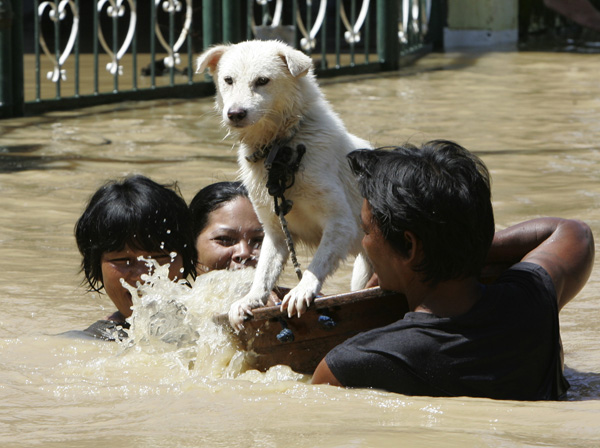Typhoon batters Philippines
( China Daily ) Updated: 2011-10-02 07:42:45
|
 |
|
Residents wade through the floodwaters with their pet dog as they evacuate to safer grounds following massive flooding in Bulacan province, the Philippines, on Friday. Heavy rains from typhoon Nesat that battered northeastern Philippines early this week filled up dams prompting officials to release water overnight. [Photo / Agencies] |
Second storm in less than a week also hits southern China
MANILA, the Philippines - The second typhoon in a week battered the rain-soaked northern Philippines on Saturday, adding misery to thousands of people, some of whom were still perched on rooftops from previous flooding.
Thousands of people were ordered to evacuate their homes after typhoon Nalgae slammed ashore south of northeastern Palanan Bay in Isabela province with winds of 160 kilometers an hour and dangerous gusts of 195 kph.
It was making a similar path across the saturated Luzon Island as typhoon Nesat, which earlier in the week killed at least 50 people, left 31 missing and thousands stranded and sent huge waves that breached a seawall in Manila Bay.
Nesat also pummeled southern China. More than 1 million people in the Guangxi Zhuang autonomous region have been affected by Nesat, the regional government said on Saturday.
The typhoon battered 23 counties in eight cities, including the regional capital Nanning, forcing 63,200 people to evacuate, the regional civil affairs department said in a news release.
At least 1 million people suffered losses ranging from destroyed homes to ruined crops, it said.
The typhoon, packing strong winds and heavy rain, toppled 387 homes and damaged 2,721 others.
Nearly 120,000 hectares of cropland were damaged, of which 3,620 hectares were rendered useless.
Rong Jiaqing, a villager in Pubei county in the suburbs of Qinzhou, said nearly all his sugarcane on about 8 hectares of farmland had been broken by the high winds.
In the Philippines, nearly 400,000 hunkered down in evacuation centers and in homes of relatives and friends along the new typhoon's path. There was heavy rainfall of about 25 millimeters an hour within the storm's 630-kilometer diameter that put the northern provinces including the capital on alert.
Isabela authorities earlier shut down electricity in the province to prevent accidents from falling power pylons and snapped cables.
The howling winds toppled trees and blew away tin roofs of some houses in Isabela's provincial capital of Ilagan. In nearby Luna township, a bus with about 30 passengers fell on its side on a rice field because of the strong winds, but no one was seriously injured, police said.
"The ground is still supersaturated and it cannot absorb more water," said Graciano Yumul, the Philippines' weather bureau chief. "This will just flow down to rivers and towns, and there is a big possibility that landslides, flash flooding and flooding could occur."
He urged residents still refusing to leave their homes despite the floods to evacuate because the water was going to rise as Typhoon Nalgae, aggravated by the seasonal monsoon, dumped more rain over the northern region, including the capital, Manila, later on Saturday.
Yumul said the evacuation is "non-negotiable" because lives are at stake.
At least five towns in the rice-growing province of Bulacan and Pampanga, north of Manila, remained submerged three days after Typhoon Nesat had moved on. "We have nowhere to go," Celenia Espino of Calumpit township said from her home, which was filled with knee-deep murky water. "We have no means of transportation out of here."
AP-Xinhua
|
|
|
|
|
|
|
|
- Traditional art, modern look: Wax printing in Guizhou
- Chang'e 5 lunar probe to land on Moon and return in 2017
- China urges G7 to push Asia's economic growth forward
- Beijing finalizes preliminarily work on congestion charge
- Two-year-old undergoes surgery without opening of heart
- Microsoft pushes Windows 10 upgrade, irritates Chinese users





















 Raymond Zhou
Raymond Zhou Op Rana
Op Rana Berlin Fang
Berlin Fang Zhu Yuan
Zhu Yuan Huang Xiangyang
Huang Xiangyang Chen Weihua
Chen Weihua